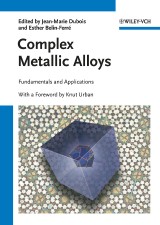Details

Complex Metallic Alloys
Fundamentals and Applications1. Aufl.
|
142,99 € |
|
| Verlag: | Wiley-VCH |
| Format: | EPUB |
| Veröffentl.: | 13.12.2010 |
| ISBN/EAN: | 9783527633043 |
| Sprache: | englisch |
| Anzahl Seiten: | 434 |
DRM-geschütztes eBook, Sie benötigen z.B. Adobe Digital Editions und eine Adobe ID zum Lesen.
Beschreibungen
Covering fundamental research as well as real-world applications, this first book on CMAs at an introductory level treats everything from atomistic details to surface processing. Comprehensive, self-contained chapters provide readers with the latest knowledge on the most salient features of the topic, selected in terms of their relevance to potential technological applications. Edited by one of the most distinguished authorities on quasicrystals and this most important of their subclasses, the contributions elucidate aspects of CMAs from a particular viewpoint: physical and chemical characteristics in the sub-nanometer regime, mesoscale phenomena, preparation and processing of thin films, and large-scale engineering properties. The whole is rounded off by a look at the commercial potential of CMA-based applications.<br> For PhD students and lecturers alike.<br>
FOREWORD <br> <br> I. INTRODUCTION TO THE SCIENCE OF CMAS<br> Brief History of the Field<br> Definition of CMAs<br> Phase Selection and Stability<br> Unexpected Transport Properties<br> Plasticity and Metadislocations<br> Outlook at Potential Applications<br> <br> II. PHYSICS OF CMAS: THEORY AND EXPERIMENTS<br> Electronic Structure<br> Chemical Bonding Effects<br> Cluster Based Solids Physics<br> Transport Properties: Inverse Matthiessen Rule, Wiedemann-Franz Law<br> Phenomenological Approaches<br> Hierarchical Scales in Reciprocal Space<br> Anisotropic Physical Properties of CMAs: Electrical and Thermal Conductivity, Magnetic Susceptibility, Hall Coefficient, Thermoelectric Power<br> <br> III. SURFACE SCIENCE OF CMAS<br> Stability of Alloy Surfaces<br> Structural Determination of CMA Surfaces<br> Electronic Structure<br> Thin Film Growth on CMA Surfaces<br> Adhesion, Friction and Wetting Properties of CMA Surfaces<br> <br> IV. METALLURGY, PREPARATION AND PROCESSING, THIN FILMS<br> Introduction to Thin Film Science<br> Deposition by MOVCD<br> Deposition by PVD<br> Structural Properties<br> Mechanical Properties<br> <br> V. SURFACE CHEMISTRY OF CMAS<br> Introduction<br> Surface Chemistry of CMAs under UHV Environment<br> Surface Chemistry of CMAs under Environmental Conditions <br> Surface Chemistry and Reactions in Aqueous Solutions<br> High-Temperature Corrosion<br> <br> VI. MECHANICAL ENGINEERING PROPERTIES OF CMAS<br> Introduction to CMAs Designed for Mechanical Applications: Structure and Properties, Possible Applications, Single-Phase CMAs and CMA-Reinforced Composites<br> Processing and Mechanical Properties of CMAs: Solidification, Glassy Precursors, Powder Metallurgy <br> The Sintering Route<br> Surface Mechanical Testing and Potential Applications<br> <br> VII. THERMOELECTRICITY, THE GRAAL OF CMAS<br> Materials<br> Properties<br> Applications/Demonstrators<br> <br> VIII. CATALYSIS CATALYSIS ON INTERMETALLIC COMPOUNDS<br> <br> IX. CMAS: FROM BASICS TO PRODUCTS<br>
<p>"Finally, it can be concluded that this book fulfils its goal to provide an overview on the current knowledge about complex metallic alloys. It can be recommended to PhD students and lecturers already working on or just starting these topics." (<i>Materials and Corrosion</i>, 2011)</p>
Jean-Marie Dubois heads the institute "Jean Lamour" at the University of Nancy, France. He is a Distinguished Research Director at the National Center of Scientific Research (CNRS) in Paris, permanent invited professor of Dalian University of Technology, China, and acting coordinator of the Complex Metallic Alloys Network of Excellence of the European Union. His research interests focus at the interplay between structural complexity in metals and alloys, electronic structure, bulk and surface properties and potential for technology. In recognition of his lifetime achievements in the field of quasicrystals he received, among others, the 2007 Mehl award from the Minerals, Metals & Materials Society.<br> <br> Esther Belin-Ferre was a Research Director at the CNRS from where she officially retired in 2005. She currently works at the Laboratory of Physical Chemistry - Materials and Radiation, in Paris. Her research is dedicated to the investigation of the electronic structure of solids, prominently quasicrystals and complex alloys, using a variety of spectroscopy techniques. She has authored more than 200 scientific publications and edited three books.<br>
Complex metallic alloys (CMA) encompass a broad family of crystalline compounds made of metals, alloyed with other elements from the periodic table. As opposed to simple crystals, such as diamond and sodium chloride, CMAs possess a complicated microscopic structure that leads to unexpected novel physical and chemical properties. This makes them promising candidates for such applications as thermoelectric devices, scratchproof surfaces or CMA-reinforced structural materials for mechanical engineering.<br> Covering fundamental research as well as real-world applications, this first book on CMAs at an introductory level treats everything from atomistic details to surface processing. Comprehensive, self-contained chapters provide the latest knowledge on the most salient features of the topic, selected in terms of their relevance to potential technological applications. <br> From the contents:<br> * Physics of CMAs: theory and experiments<br> * Surface science of CMAs<br> * Metallurgy, preparation and processing, thin films<br> * Surface chemistry of CMAs<br> * Mechanical engineering properties <br> * Thermoelectricity<br> * Catalysis on intermetallic compounds<br> Edited by one of the most distinguished authorities on quasicrystals and this most important of their subclasses, the contributions elucidate aspects of CMAs from one particular viewpoint: physical and chemical characteristics in the sub-nanometer regime, mesoscale phenomena, preparation and processing of thin films, and large-scale engineering properties. The whole is rounded off by a look at the commercial potential of CMA-based applications.<br> For PhD students and lecturers alike.
Diese Produkte könnten Sie auch interessieren:

The History, Use, Disposition and Environmental Fate of Agent Orange
von: Alvin Lee Young
Preis: 96,29 €
-
-
© 2024 media control GmbH
Alle Preise enthalten die gesetzliche Mehrwertsteuer. - AGB
- Impressum
- Datenschutzerklärung
- Kontakt
- FAQ
- Mein Konto
- Erweiterte Suche
- Widerrufsrecht
- Reader-Software
- Desktop-Ansicht
- Gutschein-Code einlösen

